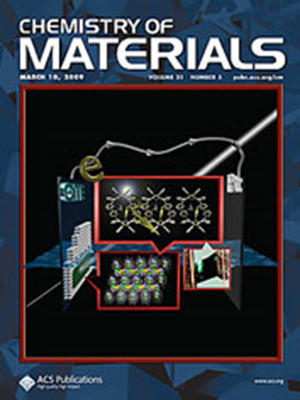LuGaO3: A Polar Hexagonal Perovskite
IF 7
2区 材料科学
Q2 CHEMISTRY, PHYSICAL
引用次数: 0
Abstract
Designing functional materials is a promising route to enhance modern technologies. Here, an unreported hexagonal perovskite, LuGaO3, is successfully synthesized in thin-film form, and its structure is characterized and compared to isostructural LuFeO3, along with solid solutions of the two (LuFexGa1–xO3, for x = 0.25–0.75). The addition of gallium was found to degrade the structural quality of LuFeO3, rendering the hexagonal phase nearly unobservable in pure LuGaO3. Extensive growth experiments (and thermodynamic phase diagrams for related systems) suggest a tendency for LuGaO3 to decompose into Lu2O3 and Lu3Ga5O12. In turn, unconventionally high synthesis pressures (500–2000 mTorr) during pulsed-laser deposition are required to stabilize the hexagonal phase. While device-based measurements demonstrate an obvious ferroelectric hysteresis for LuFeO3, the addition of gallium (seemingly) quenches any observable ferroelectric polarization while also lowering the leakage and dielectric constant. Second-harmonic-generation measurements and piezoresponse force microscopy, however, indicate that LuGaO3 is polar and can be switched under an electric field. This discrepancy with device-based measurements warrants further study, upon improving the structural quality, before ferroelectricity can be claimed unequivocally. These findings demonstrate that designer materials can be synthesized, but further refinement to predictive approaches is needed to bring them more in-line with experimental reality.一种极性六方钙钛矿
设计功能材料是提高现代技术水平的一条很有前途的途径。本文成功地以薄膜形式合成了一种未被报道过的六方钙钛矿LuGaO3,并对其结构进行了表征,并与同结构的LuFeO3进行了比较,同时对两者的固溶体(lufega1 - xo3, x = 0.25-0.75)进行了比较。发现镓的加入降低了LuFeO3的结构质量,使得纯LuFeO3的六方相几乎不可见。大量的生长实验(以及相关系统的热力学相图)表明,LuGaO3有分解成Lu2O3和Lu3Ga5O12的趋势。反过来,在脉冲激光沉积过程中,需要非常规的高合成压力(500-2000 mTorr)来稳定六方相。虽然基于器件的测量表明LuFeO3具有明显的铁电滞后,但添加镓(似乎)可以淬灭任何可观察到的铁电极化,同时也降低了漏损和介电常数。然而,二次谐波测量和压电响应力显微镜表明,LuGaO3是极性的,可以在电场下切换。这种与基于器件的测量的差异值得进一步研究,在提高结构质量之后,才能明确地宣称铁电性。这些发现表明,设计材料可以合成,但需要进一步完善预测方法,使其更符合实验现实。
本文章由计算机程序翻译,如有差异,请以英文原文为准。
求助全文
约1分钟内获得全文
求助全文
来源期刊

Chemistry of Materials
工程技术-材料科学:综合
CiteScore
14.10
自引率
5.80%
发文量
929
审稿时长
1.5 months
期刊介绍:
The journal Chemistry of Materials focuses on publishing original research at the intersection of materials science and chemistry. The studies published in the journal involve chemistry as a prominent component and explore topics such as the design, synthesis, characterization, processing, understanding, and application of functional or potentially functional materials. The journal covers various areas of interest, including inorganic and organic solid-state chemistry, nanomaterials, biomaterials, thin films and polymers, and composite/hybrid materials. The journal particularly seeks papers that highlight the creation or development of innovative materials with novel optical, electrical, magnetic, catalytic, or mechanical properties. It is essential that manuscripts on these topics have a primary focus on the chemistry of materials and represent a significant advancement compared to prior research. Before external reviews are sought, submitted manuscripts undergo a review process by a minimum of two editors to ensure their appropriateness for the journal and the presence of sufficient evidence of a significant advance that will be of broad interest to the materials chemistry community.
 求助内容:
求助内容: 应助结果提醒方式:
应助结果提醒方式:


